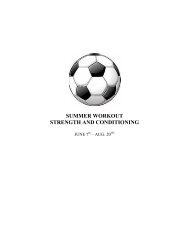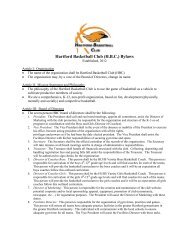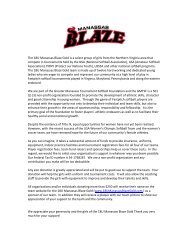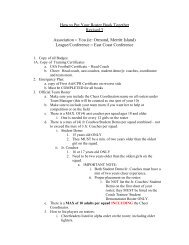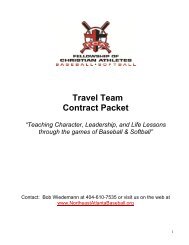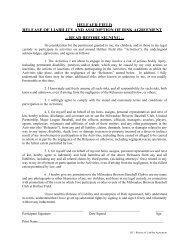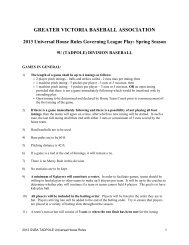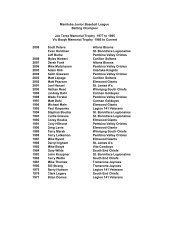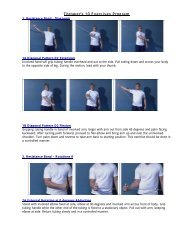Interval Throwing Program - BallCharts.com
Interval Throwing Program - BallCharts.com
Interval Throwing Program - BallCharts.com
You also want an ePaper? Increase the reach of your titles
YUMPU automatically turns print PDFs into web optimized ePapers that Google loves.
Axe et al Mar • Apr 2009<br />
throwing distance range that were significantly lower<br />
than those the other levels of players. 7 Therefore,<br />
separate outfielder programs were developed for<br />
13-year-olds and adults (see Appendix 4 available<br />
online at http://sph.sagepub.<strong>com</strong>/content/suppl.).<br />
Progressive<br />
Each throwing program is, by design, progressive. A<br />
<strong>com</strong>bination of the number, intensity, distance, and<br />
rest time between throws, as well as the type of pitch<br />
thrown (when appropriate), advances from step to<br />
step. The initiation of throwing for the injured baseball<br />
player must be based on the assumption that tissue<br />
healing is <strong>com</strong>plete, that the athlete has appropriately<br />
progressed with the exercise program, and that a<br />
satisfactory clinical examination has been conducted<br />
(including range of motion, strength, joint stability,<br />
and pain resolution). Once the athlete initiates the<br />
throwing program, the medical team must educate the<br />
athlete on the importance of following the structured<br />
progression. A study by Fleisig et al 15 illustrated the<br />
athlete’s flawed ability to estimate throwing effort. In<br />
a study of healthy pitchers targeting a 50% effort, the<br />
athletes generated ball speeds of 85% and forces and<br />
torques approaching 75% of maximum. 15 A target of<br />
75% effort achieved speeds of 90% and forces and<br />
torques of 85% of maximum. 15<br />
Advancement through each throwing program is<br />
governed by the type of injury that the athlete has<br />
encountered and the soreness rules (Table 5). 5-7<br />
The exception is the uninjured athlete who is<br />
participating in a throwing program as part of one’s<br />
preseason preparation. In these instances, progression<br />
is dictated by only the soreness rules. 6,7 The type of<br />
injury guides program progression. Categories include<br />
injuries to areas of the body other than the throwing<br />
arm (eg., back, nonthrowing arm), injuries to the<br />
throwing arm but not including the joints (eg., bruise),<br />
tendonitis, and joint injuries (eg., rotator cuff tear,<br />
postoperatively). 6,7 These categories determine at which<br />
level the athlete may initiate the throwing program<br />
and how quickly progression may occur. The soreness<br />
rules guide progression within the throwing program<br />
on the basis of an athlete’s symptoms. 5-7 Although there<br />
are general time frames for tissue healing, the health<br />
care provider must be attentive to individual variability<br />
in healing rates. Consequently, progression within the<br />
throwing program must be individualized. Given the<br />
timing and duration of the symptoms, the medical team<br />
may be able to minimize the risk of overloading injured<br />
tissues, by determining whether a baseball player is<br />
ready to progress to the next step, remain at the same<br />
step, or drop down a step. In addition, the soreness<br />
rules, along with the type of injury, dictate the amount<br />
of rest time between steps. 6,7<br />
Table 5. Soreness rules, all players. a<br />
If no soreness, advance one step every throwing day.<br />
If sore during warm-up but soreness is gone within the fi rst 15 throws, repeat<br />
the previous workout. If shoulder be<strong>com</strong>es sore during this workout, stop and<br />
take 2 days off. Upon return to throwing, drop down one step.<br />
If sore more than 1 hour after throwing, or the next day, take 1 day off and repeat<br />
the most recent throwing program workout.<br />
If sore during warm-up and soreness continues through the fi rst 15 throws, stop<br />
throwing and take 2 days off. Upon return to throwing, drop down one step.<br />
a<br />
Reprinted with permission by Lippincott Williams and Wilkins. 5-7<br />
The final step of most throwing programs is a<br />
simulated game for a given position at the maximum<br />
level of play. A true simulated game is derived<br />
from actual game data. 8 Coleman et al 12 collected<br />
3 years of data and suggested a game simulation<br />
for professional pitchers that controlled for innings<br />
pitched, pitches per inning, time between innings,<br />
and preinjury pitch mix. The goal was to determine<br />
a pitcher’s readiness to return after injury. Although<br />
Coleman’s simulated game is a good tool for<br />
establishing game readiness, it did not include a<br />
functional progression toward return to play, nor<br />
did it address the demands faced by positional<br />
baseball players or by athletes <strong>com</strong>peting below<br />
the professional level. 7 The <strong>com</strong>bination of ageand<br />
position-specific throwing programs, together<br />
with simulated games, may be used as criteria to<br />
determine return-to-play readiness. 7<br />
INDIVIDUALIZATION<br />
Data-based throwing programs that have been<br />
customized to meet the needs of the individual<br />
have the greatest potential to return the baseball<br />
athlete to one’s preinjury activities, expeditiously<br />
and safely. Many characteristics of the data-driven<br />
programs promote individualization: age- and<br />
position-appropriate programs, progression rate<br />
based on the type of injury and the soreness rules,<br />
and pitch mixes based on preinjury preferences.<br />
The throwing program for the 8- to 12-year-old<br />
pitcher is an excellent example of an individualized<br />
program, given that the long-toss portion of<br />
the program is based on the athlete’s age and<br />
preinjury pitching velocity or maximum distance<br />
thrown. There is, however, ample opportunity for<br />
the medical team to further individualize these<br />
throwing programs.<br />
Collection of preinjury data is the best method to<br />
develop a performance profile and so individualize<br />
a throwing program. To develop the programs<br />
152



